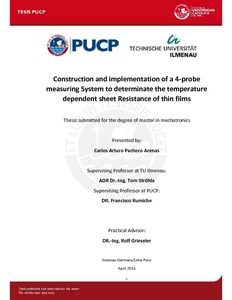| dc.contributor.advisor | Ströhla, Tom | |
| dc.contributor.advisor | Rumiche Zapata, Francisco Aurelio | |
| dc.contributor.author | Pacheco Arenas, Carlos Arturo | es_ES |
| dc.date.accessioned | 2017-04-12T14:49:11Z | es_ES |
| dc.date.available | 2017-04-12T14:49:11Z | es_ES |
| dc.date.created | 2016 | es_ES |
| dc.date.issued | 2017-04-12 | es_ES |
| dc.identifier.uri | http://hdl.handle.net/20.500.12404/8434 | |
| dc.description.abstract | In order to build machines, electronic devices, it is necessary to know all properties of the materials.
The machines and electronic devices use parts that are interconnected, the mechanical properties
are important, but for some specific tasks the electrical properties are more important. In this sense
it is necessary to predict the behavior of this parts in different temperatures to the environment.
The present thesis focus on implementation of a 4-probe measuring system to determinate the
sheet resistance of thin film samples showing the dependency of the resistivity on the film thickness
as well as on the deposition temperature. The method used to determine the resistivity is the
modified van der Pauw Method. Therefore, it is important the measurement of the current and the
voltage drop in the sample. It is also important to measure the distance between tips, in order to
calculate the resistivity. Furthermore, it is also important to find the correct transformation that
maps any four point of a plane to a new plane with four collinear points. The measurements are
controlled via LabVIEW and the measured data is displayed in the user interface. | es_ES |
| dc.description.abstract | Con el fin de construir máquinas, dispositivos electrónicos, es necesario conocer todas las
propiedades de los materiales. Las máquinas y los dispositivos electrónicos utilizan piezas que están
interconectados, las propiedades mecánicas son importantes, pero para algunas tareas específicas
son más importantes las propiedades eléctricas. En este sentido es necesario predecir el
comportamiento de estas piezas a diferentes temperaturas. La presente tesis se centra en la
implementación de un sistema de medición 4-puntas para determinar la resistencia laminar de las
muestras de las láminas delgadas, que demuestran la dependencia de la resistividad respecto al
espesor de la lámina, así como de la temperatura de deposición. El método utilizado para
determinar la resistividad es el van der Pauw modificado. Por lo tanto, es importante la medición
de la corriente y la caída de tensión en la muestra. También es importante la medición de la distancia
entre las puntas, para calcular la resistividad. Sin embargo, también es importante encontrar la
correcta transformación que mapea cuatro puntos de un plano a un nuevo plano con cuatro puntos
en lineados. Para la dependencia de la resistividad de la temperatura se utilizará el método der
Pauw van modificado. Las mediciones se controlan a través de LabVIEW y los datos medidos se
muestran en una interfaz de usuario. | es_ES |
| dc.description.abstract | Um Maschinen und elektronische Geräte zu bauen ist es notwendig alle Eigenschaften der
Materialien zu kennen. In Maschinen und elektronischen Geräte werden Teile verwendet, welche
miteinander verbunden werden, wobei deren mechanische Eigenschaften wichtig sind, aber für
manche spezifische Aufgaben sind die elektrischen Eigenschaften wichtiger. In diesem
Zusammenhang ist es notwendig vorauszusagen, wie sich das Verhalten dieser Teile bei
verschiedenen Temperaturen zur Umgebung ändert. Die vorliegende Arbeit konzentriert sich auf
die Implementierung eines 4-Punkt-Messsystems zur Bestimmung des Plattenwiderstandes von
dünnen Filmproben sowie der Abhängigkeit des spezifischen Widerstands von der Filmdicke als
auch der Fertigungstemperatur der Probe. Das Verfahren, welches verwendet wird um den
spezifischen Widerstand zu bestimmen, ist die modifizierte van der Pauw Methode. Deshalb ist das
Maß des Stroms und der Spannungsabfall in der Probe wichtig. Es ist noetig, die Entfernung
zwischen den Messpunkten zu bestimmen, um den spezifischen Widerstand zu berechnen.
Desweiteren ist es auch wichtig, die richtige Transformation zu finden, um jeden der vier Punkte
einer Ebene in einer neuen Ebene mit vier Collinearen-Punkten kartografisch darzustellen. Die
Messwerte werden mit Hilfe von LabVIEW ueberwacht, und die Messdaten werden in einer
Benutzeroberflaeche angezeigt. | es_ES |
| dc.description.uri | Tesis | es_ES |
| dc.language.iso | eng | es_ES |
| dc.publisher | Pontificia Universidad Católica del Perú | es_ES |
| dc.rights | info:eu-repo/semantics/openAccess | es_ES |
| dc.rights.uri | http://creativecommons.org/licenses/by-nc-nd/2.5/pe/ | * |
| dc.subject | Temperatura-Medición | es_ES |
| dc.subject | Resistencia eléctrica | es_ES |
| dc.subject | Películas delgadas | es_ES |
| dc.title | Construction and implementation of a 4-probe measuring system to determinate the temperature dependent sheet resistance of thin films | es_ES |
| dc.type | info:eu-repo/semantics/masterThesis | es_ES |
| thesis.degree.name | Maestro en Ingeniería Mecatrónica | es_ES |
| thesis.degree.level | Maestría | es_ES |
| thesis.degree.grantor | Pontificia Universidad Católica del Perú. Escuela de Posgrado | es_ES |
| thesis.degree.discipline | Ingeniería Mecatrónica | es_ES |
| renati.advisor.dni | 07833101 | |
| renati.discipline | 713167 | es_ES |
| renati.level | https://purl.org/pe-repo/renati/level#maestro | es_ES |
| renati.type | http://purl.org/pe-repo/renati/type#tesis | es_ES |
| dc.publisher.country | PE | es_ES |
| dc.subject.ocde | https://purl.org/pe-repo/ocde/ford#2.00.00 | es_ES |






